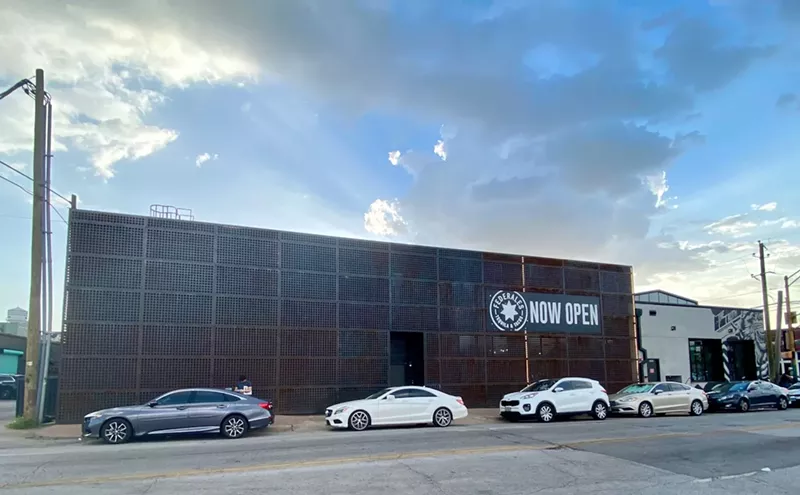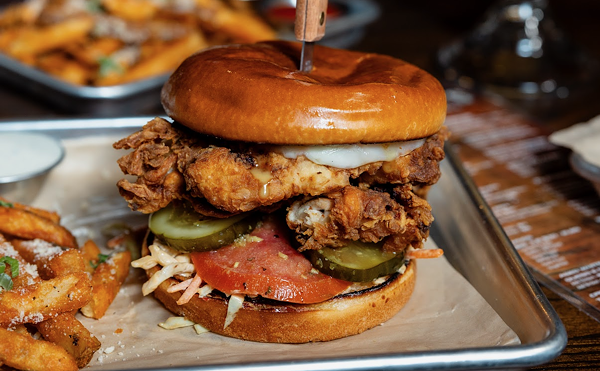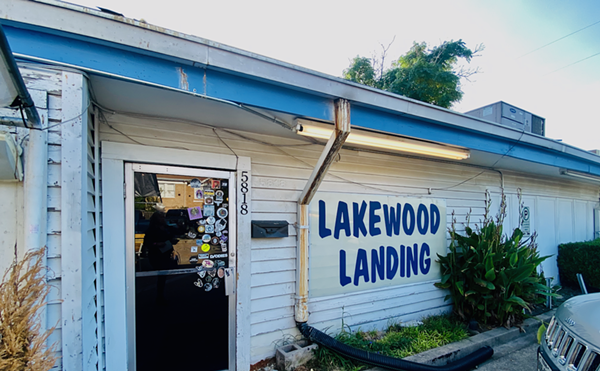It's a scene that repeats at Sambuca most weekends. Patrons dine, dance and sip cocktails, and they generally don't notice how the floor of the bar area slopes away from the stage or that large gaps exist under the doors to the restrooms. Sambuca has spent thousands of dollars and countless hours to keep these problems hidden from customers, who remain, for the most part, blissfully unaware that the building of one of Dallas' most popular, longstanding restaurants is slowly crumbling around them.
Sambuca's first home in Dallas was a converted warehouse in Deep Ellum that opened in 1991, but after 10 years, owner Kim Forsythe was keen to find a new, upscale location for the Dallas supper club.
"We were moving out of Deep Ellum; I wanted to take care of my employees because cruisers were shutting down the streets, and crime had gone up," he said. "I didn't see potential in downtown, but this side of Woodall Rodgers, on McKinney Avenue, we thought would grow, potentially. We said, 'Let's get in early, get a good lease and let the area grow up around us.'"
Forsythe and his real estate partners found an available building at 2120 McKinney Ave. but heard plumbing problems plagued the former tenants. Some due diligence was in order before they decided to move ahead.

"I didn't see potential in downtown, but this side of Woodall Rodgers, on McKinney Avenue, we thought would grow, potentially," Sambuca owner Kim Forsythe says.
Chris Wolfgang
Sambuca signed a 10-year lease with the landlord, with an option for two five-year renewals, and opened for business in 2004.
Things went well for Sambuca for the first several years, and as predicted, the Uptown area took off. The Ritz-Carlton was built across the street after Sambuca opened, and other retail and residential developments on McKinney Avenue soon followed. The plumbing work that was done before Sambuca's opening seemed to be a solid investment. Besides a few intermittent plumbing problems and sewer smells that Sambuca thought were unrelated and paid to fix, nothing major seemed to be amiss.
Behind the scenes, MetLife acquired the Sambuca building, as well as the high-rise building across the parking lot, shortly after Sambuca signed its lease. The change didn't mean much at the time to Forsythe, who dealt mostly with the property management company, which started as Trammell Crow and became CBRE.
"In the first five years, they were reasonable to deal with. It didn't seem like there were any issues to deal with and so forth," Forsythe said. "But then 2009 happens."
One evening in June 2009, Forsythe got a call from his manager about a crack in the floor in the back of the restaurant. Forsythe didn't initially think it worthy of a phone call.
"They said, 'Well, it's gone like 10 or 15 feet in one night. ... It's pretty significant,'" he said.
Forsythe let the landlord know about the crack and its rapid growth. In typical leases, the landlord is responsible for structural walls, roofs, foundation, utilities to the space and building integrity, and the tenant is responsible for the interior of the space. Sambuca's lease was no different, and CBRE sent an engineer to take a look at the crack and do some basic inspections of the building.
Three months later, on the evening of Sept. 30, Sambuca suffered a "catastrophic" failure of the main sewer line that connected the building to the city's sewer system. The bathrooms flooded with several inches of backed-up sewage, and Sambuca staff had to escort guests across the street to the Ritz to use the bathrooms before ultimately closing early. Forsythe called a plumbing company to investigate, and it worked to determine the severity of the issues.
"They made a large opening at the front of the restaurant to dig down to the main line and discovered that the main line had been crushed," Forsythe recalled.
The plumbing company dug farther under the building, uncovering stress cracks in the pipes in multiple locations as deep as 30 feet under the foundation. Forsythe alerted CBRE to the problems and explained the steps he had taken so far. At that point, CBRE told him to stop any further repairs.
"They just told us to stop working on it. We said, 'Well, they're saying the whole [line] needs to be replaced,' and they said, 'We're not paying for anything else unless you let us take it from here,'" Forysthe says.
Because the responsibility for the sewer line repairs resides with the building's owners, Forsythe and his plumbing company agreed to stop the work after putting in a temporary pipe that would let the restaurant reopen after four days. CBRE sent an engineering company to investigate the damaged pipes the following week.
The last three months of the year are Sambuca's busiest, and Forsythe was anxious to get the restaurant reopened. But he was also anxious to get an answer to how and when CBRE and MetLife planned to fix the building. Instead, his requests were met with delays.
"They investigated it the next week, and so we asked what the answer was, and the response was, 'We're looking into it,'" Forsythe said with a wry smile.
The back-and-forth continued for several months, during which Sambuca encountered more plumbing issues and was forced to call plumbing companies to clear drains and fix broken pipes in order to keep the restaurant open. It also started having problems with more cracking in floors and walls, doors that wouldn't open and damage to the restaurant's walk-in refrigerators.
"They kept telling us for months that they were still looking into it, and we'd go back to them periodically and ask for a status, but they said they were still investigating," Forsythe said. "We waited over a year and a half — it was 2011 — and we said you've got to repair this stuff. So we sent them a letter saying they were in default of the lease."

Forsythe points out a crooked door and molding that recently popped off due to the building's shifting foundation.
Chris Wolfgang
"In the midst of repairing the line, it had become obvious that the whole restaurant was starting to slope pretty significantly," Forsythe said. "We had a meeting [after the plumbing work was fixed], and we said, 'You're going to do all these repairs, right?' And they said, 'Yes, but we need to let all the moisture dry up from that leaking plumbing line, and that was causing the foundation to move.' They had engineering reports, but we weren't allowed to see them. So they said everything will be dry in 12 to 18 months."
That 12- to 18-month window was problematic for Forsythe, however. The original 10-year lease expired in 2014, and by early 2013, Sambuca was required to acknowledge its intent to exercise the first five-year renewal option.
"At this point, I've got over a million and half dollars in this place," Forsythe said.
The Uptown area was starting to come back after the 2008 recession, and Forsythe was anxious to recoup his investment in the location. Moving would've been a money-losing proposition. Confident that MetLife would fix the building — and with a letter from MetLife stating it would in hand — Forsythe exercised the renewal option in March 2013.
***
Any successful restaurant general manager knows everything going on in his or her restaurant, and Sambuca's Laura Dalager is no exception. But Dalager's role involves more than just making sure reservations are taken and staff is scheduled appropriately."I have a whole set of routines just to check around the building," Dalager said. "For example, every Tuesday, we check all the screws in the vent covers because the screws back themselves out, and the vent could fall out."
As we walk through the restaurant, Dalager and Forsythe point out old repairs, new damage and things they have learned to repeatedly check. Bathrooms are inspected regularly, and mirrors and glass are tested to make sure there is no danger of breakage.
Dalager said that since she became Sambuca's general manager in 2012, she's become quite handy when it comes to spotting building repairs that are needed, and as we continue our tour, it's obvious she's familiar with every gap and crack in the building and knows immediately if anything has shifted.
But why must Forsythe and Dalager spend so much time monitoring the building's faults when MetLife said it was going to fix them?
With the lease renewal underway, a repair letter in hand and the prescribed amount of time for the foundation to dry out and settle approaching an end, Sambuca inquired as to when the repairs would start.
"It gets to month 17 or so, and [MetLife] have another attorney for litigation that they've hired. He contacts my attorney and says they're not doing anything because this building is fine," Forsythe said.
Out of options, Sambuca filed a lawsuit against MetLife in October 2013 to force its compliance with the terms of the lease. Once the suit progressed and Forsythe's attorneys were allowed to review documents and communications from MetLife and CBRE, the scope of the case expanded.
"Originally, we were filing for breach of the lease. We basically just wanted them to do their responsibility," Forsythe said. "When we started doing discovery, what we discovered, seeing the reports we didn't have access to, it became evident that this was fraud."
Among the documents turned over in discovery was a property condition report MetLife had prepared when it purchased the building in 2004. The report noted that the slab had moved and would continue to move, and it recommended that parts of the building's foundation be repaired by 2009, when Sambuca started having problems.
In court filings, MetLife claimed that a "phased investigation" into the building issues was necessary to rule out the most likely causes of the shifting foundation. Sambuca said the phased investigation was nothing more than a ruse intended to delay repairs and ultimately drive Sambuca out of the building, at which point MetLife and CBRE could bring in a more profitable tenant.
The complexity of the lawsuit is staggering, with hours of depositions, dozens of hearings and thousands of pages of evidence and claims from both sides filling up the file. MetLife claimed that Sambuca's problems with the building stem from the original work done in 2004, and Sambuca's renewal of the lease in 2013 absolved MetLife from any claims of breach. Further muddying the case, MetLife transferred ownership of the property to a subsidiary in 2015, which forced Sambuca to amend the the lawsuit again.
The battle has spilled outside the courtroom as well. Forsythe contended that real estate and restaurant professionals have approached him after hearing rumors of Sambuca going under. Those rumors also spread to Sambuca's staff, and Forsythe has had to quell employees' concerns that they may soon be out of jobs.
And earlier this year, CBRE scheduled sandblasting of the parking garage used by Sambuca's valet company on Valentine's night, covering guests' cars with dust. Forsythe said his restaurant was never notified of the planned maintenance on his second-busiest night of the year.
The Observer reached out to attorneys from Dallas law firm Reese Gordon Marketos LLP, which is representing MetLife and CBRE in the case, but our requests for comment went unanswered. Yet eight years after Sambuca started having problems with the building and three years after filing its lawsuit, the restaurant will get its day in court when the trial gets underway next month. Forsythe said it's important for his customers and employees — some of whom have worked for him since his days in Deep Ellum — that he see this through, no matter what it costs him. He said his legal bills so far have far exceeded $1 million.
"I said to my attorneys, 'This is a lot more money than I thought I'd have to spend on this deal.' And they said, 'Well, they didn't think you'd fight,'" Forsythe said. But no matter how big MetLife is, the idea of quitting never crossed Forsythe's mind.
"Anybody else, as small a company as we have, they probably would have walked away," he said. "But in the middle of a fight, I just can't see saying uncle and walking away. Not when you know you're right."
















